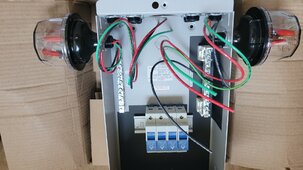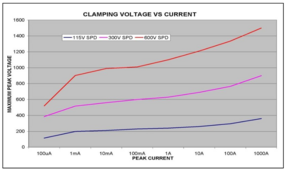This question probably got answered few times on this forum, but I can't find the answers. So forgive me for asking what may be basic knowledge to others.
My current "old" PV system uses no SPD at the array. There is 25m of underground wire, then there is a connection box (on an outside wall of a building, right next to my on-grid inverter) and I have PV DC rated surge protection there and DC breakers. SPDs are grounded to my "main" ground. The main ground is the house and the external building with the inverter. Both grounds are tied together (bonded only in the main panel).
I've watched some videos by Mike Holt and I'm convinced single point grounding is best. So I may even disconnect the extra ground electrode at the second building.
But now the question of surge protection for my new panels comes. These are silicon panels (my old ones are thin film). I believe they are a lot more susceptible to surge damage. So I decided to put some type 2 SPDs at the array. I also run an extra wire to provide the "main" ground.
But then I started having doubts about the idea of placing SPD tied to remote ground while the mount and panel frames are all connected to local ground (all metal mount in concrete).
Imagine a nearby lightning strike, let's say 50m away. This will create a voltage gradient through the earth and the local ground of the panels will suddenly be thousands of volts higher than the system ground. This very high voltage will now "probe" panel insulation which is rated at 1500V only and one or more panels will experience breakdown. This high voltage will flow onto the DC+ or DC and then SPDs will do their job protecting the rest of the system.
Now imagine a second scenario. This time SPD ground is tied to local array ground. Same lighting strike. Local ground goes to many thousands of volts. The SPD activates(it works bidirectionally) and raises DC+ and DC-. Panels are protected because their ground to DC potential doesn't exceed the rating by much... But wait... We now have DC+ and DC- at many thousands of volts as referenced by the main system ground. If there is another set of SPDs right at the AIOs PV input tied to system ground a fight of two sets if SPDs ensues. If the gradient between two grounds is too high both sides get damaged.
So in that case one may say, fine, let's tie the array ground (the mount) to system ground too, so the SPDs do not fight eachother. But that essentially forms an auxiliary electrode with all it's disadvantages (as per Mike Holt). One of them being huge currents flowing on the wire connecting these grounds in case of a nearby strike and if the wire is long it may not even help much because of the impedance of that connecting wire.
So what to do? Not do any SPDs at the array as I did with my old one and hope for luck?
Install SPDs tied to system ground at array? (this seems bonkers, it only protects the inverter, why put it at the array?).
Or connect both grounds together?
My current "old" PV system uses no SPD at the array. There is 25m of underground wire, then there is a connection box (on an outside wall of a building, right next to my on-grid inverter) and I have PV DC rated surge protection there and DC breakers. SPDs are grounded to my "main" ground. The main ground is the house and the external building with the inverter. Both grounds are tied together (bonded only in the main panel).
I've watched some videos by Mike Holt and I'm convinced single point grounding is best. So I may even disconnect the extra ground electrode at the second building.
But now the question of surge protection for my new panels comes. These are silicon panels (my old ones are thin film). I believe they are a lot more susceptible to surge damage. So I decided to put some type 2 SPDs at the array. I also run an extra wire to provide the "main" ground.
But then I started having doubts about the idea of placing SPD tied to remote ground while the mount and panel frames are all connected to local ground (all metal mount in concrete).
Imagine a nearby lightning strike, let's say 50m away. This will create a voltage gradient through the earth and the local ground of the panels will suddenly be thousands of volts higher than the system ground. This very high voltage will now "probe" panel insulation which is rated at 1500V only and one or more panels will experience breakdown. This high voltage will flow onto the DC+ or DC and then SPDs will do their job protecting the rest of the system.
Now imagine a second scenario. This time SPD ground is tied to local array ground. Same lighting strike. Local ground goes to many thousands of volts. The SPD activates(it works bidirectionally) and raises DC+ and DC-. Panels are protected because their ground to DC potential doesn't exceed the rating by much... But wait... We now have DC+ and DC- at many thousands of volts as referenced by the main system ground. If there is another set of SPDs right at the AIOs PV input tied to system ground a fight of two sets if SPDs ensues. If the gradient between two grounds is too high both sides get damaged.
So in that case one may say, fine, let's tie the array ground (the mount) to system ground too, so the SPDs do not fight eachother. But that essentially forms an auxiliary electrode with all it's disadvantages (as per Mike Holt). One of them being huge currents flowing on the wire connecting these grounds in case of a nearby strike and if the wire is long it may not even help much because of the impedance of that connecting wire.
So what to do? Not do any SPDs at the array as I did with my old one and hope for luck?
Install SPDs tied to system ground at array? (this seems bonkers, it only protects the inverter, why put it at the array?).
Or connect both grounds together?





